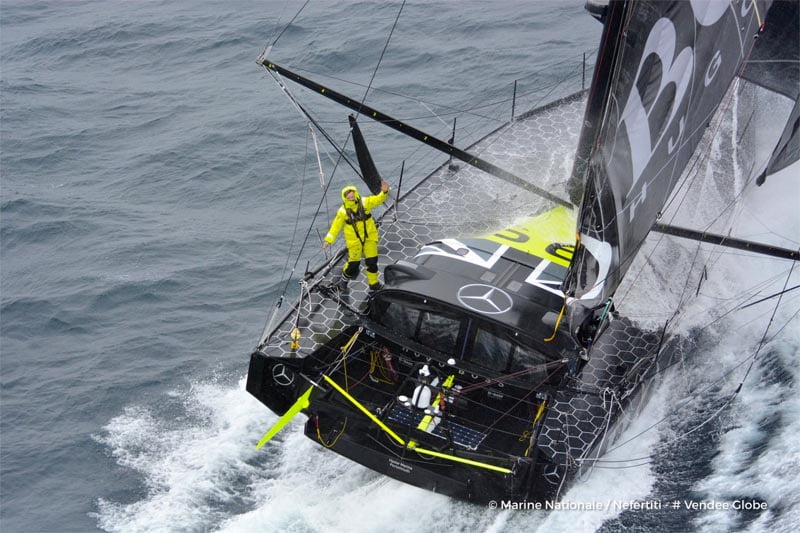The Vendée Globe is going down to the wire with the leading pair of Armel Le Cléac’h and Alex Thomson split by just 78 miles as they enter the final 1,000 miles to the finish.
Thomson has been playing catch-up since Le Cléac’h took the lead on December 2 but as the race enters its final few days he has transformed from the chaser into the hunter, ruthlessly stalking his French rival in the hope of being able to deliver the killer blow before the race is up. The British skipper delivered a timely warning to French skipper Le Cléac’h today when he smashed the world record for the greatest distance sailed solo in 24 hours. Hugo Boss skipper Thomson maintained a staggering average speed of 22.4 knots in the 24 hours leading up to the 0800 UTC position update to notch up 536.8nm. The distance breaks the 534.48nm record set by François Gabart in the 2012-13 Vendée Globe that he went on to win, beating Le Cléac’h by just three hours. In that respect the new record could be considered a good omen by Thomson, who is aiming to become the first Brit in the race’s 27-year history to win it. He actually beat Gabart’s record two weeks into the race, sailing 535.34nm in 24 hours, but the rules of the record state it must be superseded by one whole mile. Thomson previously held the record between 2003 and 2012 with a distance of 468.72nm. The new record will now be ratified by the World Sailing Speed Record Council.
Banque Populaire skipper and pre-race favourite Le Cléac’h has hardly been easing off on his run into the finish. Over the same 24-hour period he covered 515 miles at an average of 21.5 knots. By the 1400 UTC report Le Cléac’h was matching Thomson’s 21 knots of boat speed with a slim buffer of 78 miles at the latitude of Cape Finisterre on the north-west point of Spain. Rather than head for the finish line in the Vendée port of Les Sables d’Olonne the duo must continue north east to avoid the centre of an anticyclone currently blocking their path east. By tomorrow the winds and therefore boat speeds will have dropped, and several days of light-wind sailing lie ahead. Both skippers are expected to finish on Thursday January 19, potentially just a few hours apart.
Throughout the fleet, today split by 9,000nm from head to tail, there has been admiration for Thomson’s new record. “Alex’s record is seriously impressive,” said New Zealander Conrad Colman, some 6,000nm behind the leaders. “I’ve been watching his average boat speed closely, and the idea of staying at 23 knots for 24 hours is absurd. I think the new generation of IMOCAs are incredible and as soon as I put my feet back on the ground I’ll be looking to cement a new project for myself and join the club ‘flying’.” Yann Eliès, skipper of fifth-placed Queguiner-Leucémie Espoir, added: “It’s a great performance. Alex seems to be able to keep up average speeds a little above those of Armel, so we’ll be watching the final four days closely.”
Thomson was not the only skipper with cause for celebration today. Fabrice Amedeo in 11th and Arnaud Boissières in 12thboth rounded Cape Horn, thesouthern tip of South America, to begin their ascent through the Atlantic to the finish line. Amedeo rounded at 0140 UTC with Boissières following suit just over four hours later. Thirteenth-placed Swiss sailor Alan Roura will be next round Cape Horn, adrift by just 30 miles at 1400 UTC. Rich Wilson in fourteenth still has 150nm to go. Meanwhile 65-year-old Dutch sailor Pieter Heerema passed Point Nemo, the most remote place on the planet more than 1,700 miles from inhabited land. “Now I want to get around Cape Horn as quickly as possible,” he said. “It’s a really key landmark. We’re now 70 days into this race and there’s still a long way to go. I’m enjoying it but I’ve also more or less had enough.”

